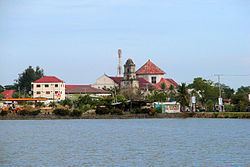Country Philippines Founded February 1, 1590 Time zone PST (UTC+8) Local time Thursday 11:47 AM Dialling code 75 | Region Ilocos (Region I) Barangays Area 118.5 km² Province Pangasinan | |
 | ||
District 2nd district of Pangasinan Weather 29°C, Wind N at 3 km/h, 68% Humidity Neighborhoods Gayaman, Buenlag, Camaley, Parayao | ||
Philippine trip 2012 pt 15 rudy jing eatery in binmaley pangasinan philippines wed nov 14th 2012
Binmaley (Pangasinan: Baley na Binmaley; Ilocano: Ili ti Binmaley) is a 1st class municipality in the province of Pangasinan, Philippines. According to the 2015 census, it has a population of 83,052 people.
Contents
- Philippine trip 2012 pt 15 rudy jing eatery in binmaley pangasinan philippines wed nov 14th 2012
- Map of Binmaley Pangasinan Philippines
- Barangays
- References
Map of Binmaley, Pangasinan, Philippines
Binmaley is located along the western coastland of Pangasinan facing the Lingayen Gulf, in between Lingayen and Dagupan City. On January 8–9, 1945, the amphibious forces of U.S. General Douglas MacArthur used the town's beach, designated as "yellow beach", alongside the beaches of Lingayen, Dagupan, and San Fabian, in their landing operations to liberate Luzon from Japanese occupation during World War II.
The town is famous for its bangus (milkfish) aqua-culture, due to the existence of its numerous fishponds (pokok in the Pangasinan language). However, because of constant siltation over the past several years from mine tailings upstream from Agno River (due to mine operations in neighboring Benguet Province), and the overuse of artificial fish feeds, the bangus industry has suffered from fishkill, fewer viable fishponds and lower harvests. As a result, many formerly productive fishponds have been converted into large commercial and residential lots. This phenomenon is beginning to seriously threaten the unique Binmaley fishpond industry. Current Government action is inadequate due to strong pressures from other competing commercial interests, not to mention fishfeed producers.
Binmaley's town center has a Neo classical church dating back to the 17th century. It also became famous throughout the Philippines for the outstanding academic achievements of students (and its distinctive corps of military cadets) from its Binmaley Catholic High School, especially when it was headed by a German priest, Fr. Leo Behneke, in the 1960s and 1970s. Its name roughly means "the place which became a town" or "went to town" in the Pangasinan language.
Binmaley, is famously known for its "Sigay Festival". The Pangasinan word sigay broadly translates to harvest, or a time to gather the rich yields of the farm, the sea, the ponds and the rivers. It also relates to a contraction of the words silew, meaning light, and gayaga, meaning merriment. It was Mayor Lorenzo "Enzo" Cerezo who pioneered and founded "Sigay Festival".
Barangays
Binmaley is politically subdivided into 33 barangays.
